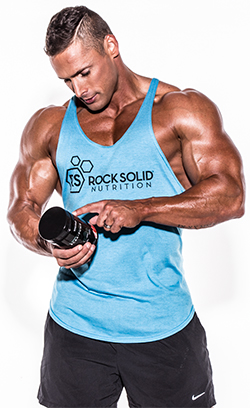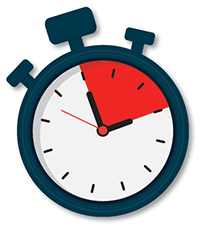25 Tips to Boost Your Strength

You want to grow and add some serious muscle? From training tips to supplement science and nutrition advice, we’ve got ya covered.
Building muscle isn’t an easy task for many, which is probably why we’re always being asked for tips on how to pack on slabs of rock-hard mass. This article will cut through the muscle-building confusion and outline critical muscle-building tips. Of course, we could fill an entire issue with other tips in addition to the ones in this list, but these are the top 25 we’ve compiled for you. Get growing!
1. Warm Up Before Training
Fredrich Nietzsche once famously said, “He who would learn to fly one day must first learn to stand and walk and run and climb and dance; one cannot fly into flying.” The same goes for your training. Before you hit the heavy weights in your workout, you should always begin with a warm-up to get your heart pumping and your blood flowing. You may also want to incorporate some dynamic mobility moves to get your body ready for the onslaught of weight. And before you tackle any big lifts, it’s wise to incorporate 2 or 3 warm up sets to get your body acclimated to the movement. The worst thing you can do is hurt yourself on your first set because you didn’t take the first 10 minutes you were in the gym to do a proper warm-up. You can’t grow if you’re injured. Always train smart.

2. Use Low to Intermediate Reps for Strength and Growth
Research shows that low- to intermediate-repetition resistance-training programs (3 to 11 reps) induce a greater hypertrophic effect and improve maximal strength significantly more than high-repetition programs (20 reps and up). Try to periodize your training into different phases that focus on different rep ranges and goals. For example, use 4 to 6 reps for strength building and then increase to an 8- to 10-rep range for hypertrophy.
 3. Cover Your Essential Supplement Needs
3. Cover Your Essential Supplement Needs
Foundational supplements, such as a multivitamin/mineral, good-quality whey protein powder, greens powder, fish oil, and fibre, should make up the base of your supplement plan. If you don’t have your nutritional basics in order with these essential supplements, you’ll never maximize your body’s muscle-building potential. Although none of these supplements are considered “muscle builders” per se, when used consistently and in combination, they can have positive effects on growth over time.
4. Train with a Partner
If you really want to grow, you need someone who shares your desires, will push you to achieve those goals, be there to spot you when you try a heavier lift, and kick ass when you want to bail on a training day at the gym.

 5. Consume Carbs and Protein After Training
5. Consume Carbs and Protein After Training
Although there are quite a few different philosophies about enhancing muscle recovery for growth after training, recent studies support the ingestion of high-glycemic carbohydrates alongside protein immediately after a workout for the most effective recovery. A study done at McMaster University in Hamilton, Ontario, demonstrated that carbs work to increase insulin response and replenish depleted glycogen stores in muscle and the liver. Meanwhile, the stimulated insulin response will work to shuttle amino acids to damaged muscles for more efficient repair, consequently increasing muscle growth.
6. Learn Good Form in the Gym
If you’re going to do something, do it the right way. There’s no sense in doing an exercise wrong. You won’t get the results you should, and you could end up hurting yourself. Proper form in the gym is paramount. If you’re new to training, make sure you get a trainer or coach so you can learn proper form for exercises and adopt good habits early on. Although “cheat” exercises certainly have their place on occasion, your training routine should always be based on solid fundamentals and good, clean form when it comes to execution.

7. Get Plenty of Good Quality Sleep
You’ve surely heard it before: You have to sleep to grow! The truth is, there’s much science to support this simple phrase. In fact, lack of sleep is related to increased cortisol levels, improper glycogen storage, decreased growth hormone production, and impaired delta wave sleep. This combination of negative effects makes it difficult to increase muscle mass. Scientists have found that 8 to 10 hours is the ideal amount of time to sleep, thus avoiding the negatives mentioned above. Proper sleep will work to regulate hormone production, improve glycogen storage, and decrease cortisol levels. The result is mood and energy enhancement, less fat gain, and an easier ability to pack on lean muscle mass! This is also important to the entire anti-aging process.
8. Help Boost Growth Hormone with Sleep Supplements
Growth hormone and sleep go hand in hand. The better the sleep you get, the more GH your body will release. There are few good natural growth hormone-boosting ingredients available, and these same ingredients also support improved sleep, which is a good situation for anyone looking to pack on muscle. Two of the best natural growth hormone stimulators are gamma-Aminobutyric acid (GABA) and melatonin. GABA is an inhibitory amino acid and has a direct affect on growth hormone secretion. In one study, resistance-trained men ingesting 3 grams of GABA daily increased growth hormone by as much as 400 percent! Melatonin is a pineal hormone and a powerful antioxidant that affects GH secretion by activating central neural pathways at the hypothalamus level. L-theanine and 5-HTP are other ingredients that can effectively promote better sleep.
 9. Focus on Complete Range of Motion
9. Focus on Complete Range of Motion
Weight training for muscle growth is most effective when a complete range of motion is performed for every exercise. A study conducted at the University of Rio Grande in Porto Alegre, Brazil, found that full range of motion and partial range of motion can both trigger muscle growth; however, results of the study showed that full range of motion has a more pronounced effect on strength growth. With greater strength increases, more muscle fibres are recruited to lift the heavier weight, and, in turn, more muscle fibre growth is stimulated.
 10. Eat Every 3 Hours
10. Eat Every 3 Hours
Research shows that you need to take in at least 20 grams of protein to stimulate an anabolic effect in the body. Furthermore, protein specialists at McMaster University and in Australia found that consuming 20 grams of protein every three hours is most effective at stimulating muscle protein synthesis over the course of a 12-hour period. So, make sure you take in at least 20 grams of protein with every meal, and try to never go more than three hours without eating a meal or having a shake. You have to eat to grow.
11. Support Growth and Recovery with L-Carnitine
Recent research studies show that carnitine supplementation can upregulate anabolic hormone receptor sites. The best form of L-carnitine for this purpose is L-carnitine l-tartrate (LCLT). Research also shows that LCLT can reduce exercise-induced muscle tissue damage and speed recovery. The ideal dosage is in the 1,000- to 3,000-milligram range. In fact, studies conducted at the University of Connecticut showed that subjects ingesting 2 grams of LCLT for three weeks had significantly reduced biochemical markers of purine metabolism, free radical formation, muscle tissue disruption (myoglobin, creatine kinase), and muscle soreness after training. In a nutshell, this means that LCLT supplementation is effective at optimizing recovery and muscle tissue growth after training!
12. Never Neglect the Basic Big Strength Moves
If you want to get big and strong, you have to lift like it. And no exercises will serve your body better than the three lifts that should be part of every bodybuilder’s repertoire: the bench press, the deadlift, and, of course, the squat. These mandatory compound movements are the foundation on what building a strong physique is based on. If you’re not doing all three of these as part of your weekly training regimen, we give you permission to kick yourself in the butt. Other basic strength moves include rows, lat pulldowns, lunges, dips, and the military press. Remember, compound movements are your bread and butter when it comes to building muscle. And you should always perform your heavy compound movements at the beginning of your routine when you’re fresh and at your strongest, and save the isolation exercises for the latter part of your workout.

13. Use Intra-Workout Supplements
During an intense workout, a cascade of physiological reactions takes place in your body, priming it for growth and repair. To take full advantage of your efforts in the gym, you should quickly replenish your body with the nutrients it requires, and this can be accomplished with an intra-workout powder that includes high-molecular-weight carbohydrates. Recent scientific evidence shows that high-molecular carbs, such as waxy maize starch, are the best type of carbs to consume during your workout to enhance recovery, performance, and muscle growth.

14. Be Patient and Realistic
Everyone wants quick and noticeable results, but being patient and realistic is the best approach. Setting realistic short-term and long-term goals will work to get you to your goals much quicker. Furthermore, get to know your body and pace yourself. Increasing weight and intensity during training sessions should happen gradually to avoid injury. This approach will also build denser muscle. Finally, patience will help prevent overtraining and allow your body the time that it needs to properly repair for optimal muscle-growth.
15. Grow with Glutamine
Glutamine is the most abundant free amino acid in the body, and many studies show that intense exercise can cause a decrease in plasma glutamine levels. Scientists believe that a decrease in glutamine levels can cause a cascade of negative effects, which can easily be corrected with glutamine supplementation. Glutamine is a great recovery supplement, and it also has cell-volumization properties that can help trigger anabolic effects in muscle cells.
16. Eat Plenty of Good Fats
It’s common to see “fat free” advertised on many products as though fat is some sort of enemy. In reality, good fats (omega-3, -6, and -9) are critical nutrients for muscle growth. Research shows that dietary fat is essential for optimal protein synthesis. Fats are essential for testosterone production in the body. Omega-3 fatty acids have the added benefit of providing anti-inflammatory benefits, and there’s much evidence to suggest their positive role in preventing heart disease.
17. Mix It Up to Avoid Plateaus
A surefire way to become stagnant and cause your gains to slow to a snail’s pace is to get caught in a training rut. It’s no surprise that if you do the same exercises over and over again, your body gets accustomed to them and that’s when your progress begins to flatline. But on the flip side, don’t go changing your whole routine every two weeks. Instead, incorporate one or two new exercises per body part every four to six weeks, and take a couple exercises out of the rotation. This way, you will be consistently challenging your muscles from new angles but not constantly overhauling your workouts every time you step into the gym.
 18. Perform Moderate Cardio 2 or 3 Times a Week
18. Perform Moderate Cardio 2 or 3 Times a Week
If you’re aiming to build muscle, you should also be concerned about your overall health. Perform moderate cardio a few times a week. We aren’t talking about an extreme HIIT program or endless hours of solid-state cardio performed on just a treadmill as part of an intense fat-burning regimen. We want you doing cardiovascular activities to increase your overall health. Take 30 minutes a few times a week to be active in enjoyable, moderate cardio. Go for a bike ride with your spouse. Take your dog for a run. Do laps in a swimming pool. We know what you’re thinking … but don’t worry that some moderate cardio work is going to cannibalize your muscle gains. Poor nutrition and inadequate effort in the gym are much more likely culprits to limit your gains. Cardio performed in moderation is great for your heart, overall health and makes you feel great. But don’t overdo the cardio. The goal here isn’t to accelerate fat loss but to increase general health.
19. Supplement with Creatine
Creatine is the world’s most heavily researched sports supplement and has the ability to increase strength, power, athletic performance, and, of course, muscle growth. Anyone who’s looking to pack on muscle should definitely include a good creatine supplement in his or her regimen. Supplementation with creatine has been proven in various types of clinical studies. It works to replenish muscle energy (ATP) by supplying more phosphate molecules to muscle cells. In the gym, this translates into more muscle strength and endurance. Creapure creatine monohydrate is a great choice, but our favorite type of creatine right now is creatine hydrochloride. It’s more soluble in water than creatine monohydrate, and this means that your body can use it quicker, without uncomfortable side effects such as bloating. Because of these features, creatine HCl is quickly becoming the most popular creatine choice.

20. Have More Sex
Don’t get fooled by the old myth that sex is bad for athletes and bodybuilders. The truth is that knocking boots won’t have negative effect on your ability to pump iron. Engaging in sexual activity stimulates testosterone production, burns calories (we did talk about performing enjoyable cardio earlier in this article), and relieves stress. These are all things that your body needs to help maintain balance. However, we’d recommend spacing out your training from your bedroom antics. We’d suggest at least four to six hours between intercourse and hitting the gym. This gives the hormonal status of your body to return to its normal level and keep your strength and energy up. You may also want to consider supplementing with zinc, which is essential to your body producing testosterone, and zinc is released when you orgasm.
 21. Remember to Stretch
21. Remember to Stretch
Stretching is often neglected by many newbies to hardcore gym-goers … and that’s a big mistake! Not only is stretching an important to increasing your flexibility, alleviating aches and pains, and improving range of movement, but it also plays a critical role in muscle size and its growth potential. Your muscles are encapsulated in a resilient covering of connective tissue called fascia—and that stuff is tough! It’s so tough, in fact, that it can severely restrict the growth of your muscles. This tough connective tissue works to restrain the muscles within. And the way to help them to grow is to stretch the fascia out. And the best time to do that hard stretching is when the muscles are engorged with blood from a killer pump during training. By stretching hard when you’re fully pumped, you put greater pressure on the fascia, allowing it to expand. But be careful! A good stretch can quickly become a bad stretch if you injure yourself with a torn muscle. Remember, when you attempt to do a hard 20- to 30-second stretch of a muscle to affect and expand the fascia, you should only ever feel a strong, steady pulling sensation—and never any sharp or intense pain.
22. Train Slow to Grow
The lifting tempo prescribed in training programs is written in a sequence of four numbers (e.g., 6-0-6-0). The first number represents the eccentric phase, the second number represents the stretched phase, the third number represents the concentric phase, and the fourth number represents the peak contracted phase. The number assigned to each phase of the tempo represents the number of seconds you should take to complete each phase. A recent study conducted at McMaster University showed that slower tempo training (six-second concentric and eccentric actions) elicited greater responses in mitochondrial and sarcoplasmic protein synthesis than faster tempo training (one-second concentric and eccentric actions). Another study showed that using 55 to 60 percent 1RM with longer time under tension per set (three-second concentric and eccentric actions) was just as effective for muscular hypertrophy and strength gains as using 80 to 90 percent 1RM with faster sets (one-second concentric and eccentric actions). So, vary your tempo to keep your muscles guessing. Try three- to six-second slow reps for a while, and then switch back to faster tempo training.
 23. Supplement with BCAAs
23. Supplement with BCAAs
Branched-chain amino acids (BCAAs) are a group of essential amino acids that play a key role in protein synthesis (aka muscle growth). The three BCAAs are leucine, isoleucine, and valine. Countless scientific studies have confirmed the powerful effects that BCAAs have on muscle growth at the cellular level. The best times to supplement with BCAAs are before, during, and after exercise. In a recent study, resistance-trained males took a daily total of 2 grams of L-glutamine and 3.3 grams of BCAAs for three weeks before commencing a fourth week of supplementation with high-intensity total-body resistance training. Blood samples revealed that testosterone levels were significantly higher and cortisol and creatine kinase levels (markers for muscle damage) were significantly lower in the group consuming BCAAs and glutamine during and following resistance training.
24. Don’t Overtrain
If you’re obsessed with the notion of getting bigger and stronger, you also have to accept the fact that training too much is counterproductive to muscle growth. If you find yourself in the gym for two hours every workout, you‘re overtraining. The ideal amount of time to spend on one workout is probably 45 to 60 minutes. After an hour of intense training, your cortisol level will increase (leading to fat storage and muscle breakdown), and your GH and testosterone levels will be in the toilet. If you find yourself in the gym every single day, you‘re overtraining. A good rule of thumb is two days in the gym and one day off. Give your body a chance to recuperate. After all, it’s during recovery time that your muscles grow. If you’re constantly doing exercises to failure, you‘re overtraining. Although occasionally training to failure has its place, it’s not something you want to be doing in every workout. And if you never take time off from the gym, you‘re overtraining. Don’t be afraid to take a week off from the gym. Taking one week off every three months is perfectly acceptable. This gives you a chance to recharge your batteries and your body gets some serious recovery time. If you're unsure on how often to train, read more by John Cardillo who is the premier fitness expert on the entire recovery process.

25. Read Muscle Insider
Yes, we are completely tooting our own horn with this tip. And why not? We have some of the most knowledgeable and diverse writers who address all the important topics you’re interested in, including health, strength building, nutrition, supplementation and training with science-backed advice. Remember, this is a service magazine—and we are committed to servicing our readers with all the information needed to help them achieve their physique goals.
Get articles delivered to you each month by signing up to the FREE Muscle Insider newsletter. Just click here.




